Prima ABM6 Manual
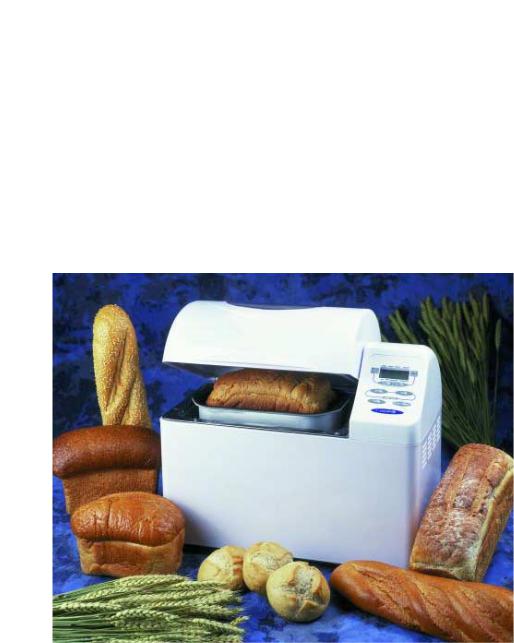
page 1 |
Home Bakery |
Home Bakery
Instruction Manual & Recipes
ABM 6

page 2 |
Home Bakery |
Use your loaf!
Please read the instructions START HERE
!
INTRODUCTION
Your Prima Home Bakery is the result of Prima’s many years of experience with bread making machines. Whether you have never made bread before or if you have made your own bread for years, the information in this booklet is essential if you are to obtain the best from your machine.
There are a number of key differences between manual bread making and machine bread making. It is best to approach the subject without any pre-conceived ideas or expectations.
This book has been designed to ensure that you get outstanding results right from the first loaf you make. There are a number of recipes included, which use all the various programmes and functions of the machine. These recipes have been designed to give you an instinctive feel for the machine. This will create a pattern of success that will eventually lead to your adapting or creating your own recipes. Indeed, you will probably find that most other recipes are variations of those found within this book.

page 3 |
Home Bakery |
PLEASE KEEP THE BOX AND PACKAGING
THE PACKAGING IS SPECIALLY DESIGNED TO TRANSPORT THE APPLIANCE SAFELY. IF YOU EVER NEED TO RETURN THE UNIT FOR A SERVICE IN THE FUTURE THERE IS A GOOD CHANCE IT WILL ARRIVE DAMAGED IF ANY OTHER TYPE OF PACKAGING IS USED.
• Important safety information.
Please read & retain for future reference.
•Please read through all the instructions before using the breadmaker.
•Be sure to use suitable mains supply 220-240V ~ AC
•DO NOT touch hot surfaces during operation.
•DO NOT allow children to operate this machine unsupervised.
•NEVER place hands/fingers into the bread pan whilst the machine is in use.
•DO NOT immerse plug, cord or base in water or other liquids.
•DO NOT use the breadmaker outdoors
•KEEP the breadmaker at least 50mm away from walls or any other objects when in use.
•ALWAYS unplug the appliance when not in use or before cleaning.
•ALWAYS use on an even surface & check that the rubber feet have a secure grip.
•DO NOT allow power cord to hang over edge of counter or work surface.
•ALWAYS use two hands when moving the machine.
•CLEAN the outside of the breadmaker with a damp cloth only. The bread pan should be cleaned after each use with mild detergent solution, rinsed and dried thoroughly.
•IF the unit is dropped or becomes damaged in any way, do not use but call Prima Service first (number at back of book).
THIS APPLIANCE IS FOR HOUSEHOLD USE ONLY
PLEASE SAVE THESE
INSTRUCTIONS
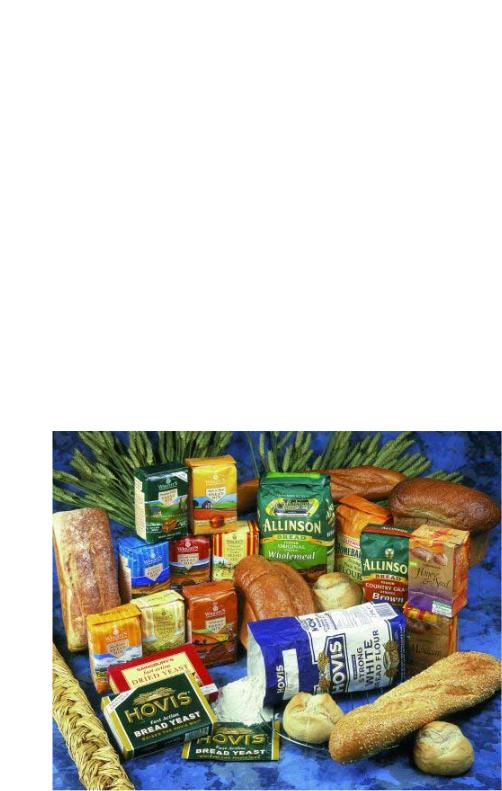
page 4 Home Bakery
• ABOUT BREAD |
1 |
Bread is one of the oldest foodstuffs we know. Soon after humans first learnt to plant seeds, bread became the staple food of many cultures world wide. Since then each culture has developed it’s own method of making bread using local ingredients and processes unique to them. This trend continues today. Even pre-packed supermarket bread differs in taste and texture from country to country. No matter how varied the range of breads on offer in bakers shops or supermarkets, there is nothing quite like the warm fragrance and taste of fresh home-made bread.
Just a few of the ingredients available from local shops & supermarkets

page 5 |
Home Bakery |
|
|
• ABOUT BREAD MAKERS |
2 |
With the continued success of the Prima Home Bakery it is nice to know that technology is actually helping to preserve the art of home bread making for generations to come.
Like most kitchen appliances, your bread maker is a laboursaving device. The principal benefit is that all the kneading, rising and baking is performed within a space saving, selfcontained unit. Your Prima Home Bakery will easily produce superb loaves time and again provided the user follows the instructions and understands a few basic principles. Unless you enjoy eating breeze blocks, it is not wise to expect the machine to think for you. It cannot tell you that you’ve forgotten the yeast or that the flour was the wrong type or measured incorrectly.
Prima ABM6

page 6 |
Home Bakery |
|
|
• INGREDIENTS |
3 |
The most important part of the bread making process is the wise selection of ingredients. You and your Prima Home Bakery will produce outstanding results with the right ingredients. Just apply this simple rule: Best ingredients - best results, poor ingredients - poor results. For example; if good yeast, good flour and cold water were thrown together and mixed in an old bucket the mixture would still rise! Nothing the breadmaker does will prevent the dough from rising so if your loaf does not rise it is most unlikely that the bread maker is to blame. It is probably due to the ingredients. In order to save you time we have included information on each major element used in the making of bread which will enable you to obtain perfect results first time every time. See the appendix at the end of this book for a list of suppliers of quality ingredients.
• FLOUR |
4 |
In bread making the most important element in the flour is the protein called gluten, which is the natural agent that gives the dough the ability to hold its shape and retain the carbon dioxide produced by the yeast. The term ‘strong flour’ means that it has a high gluten content. It has probably been milled from hard wheat and is particularly suitable for bread making.
In the UK the taste and gluten content of flour varies with each brand. At Prima we use Homepride Harvest Gold Strong White, Strong Brown or Wholemeal flour for product testing because it gives consistently good results. Other good brands are Sainsbury’s own brand, Hovis bread machine flour or McDougals strong white flour. Safeway’s own brand of bread flour is also quite good. You may wish to approach your local mill for flour. If you do, be sure to specify that you require a fine ground flour with a high protein content if you want light well-risen loaves. See the appendix at the end of this book for suppliers of good quality flour.

page 7 |
Home Bakery |
|
|
|
|
• BROWN FLOUR (or FARMHOUSE FLOUR) |
5 |
|
Brown flour contains about 85% of the wheat kernel. Much of the bran part of the wheat kernel has been removed. Loaves made with all brown flour tend to be smaller than white loaves due to the lower gluten content but there tends to be more flavour and texture to brown loaves. When buying this type of flour the strong, finely ground type will give better results in the breadmaker.
• WHOLEMEAL OR WHOLE-WHEAT FLOUR |
6 |
This type of flour contains all of the original wheat kernel including the bran; the tough outer skin of the wheat which is an excellent source of fibre. As with the brown flour, you should specify a strong fine ground variety when using your breadmaker. The bran in the wholemeal flour inhibits the release of gluten so wholemeal loaves tend to be smaller and more dense than white loaves. However, the flavour is superb (try the honey wholemeal recipe). Your Prima Home Bakery has a special process for wholemeal bread, which devotes more time to the kneading and rising processes.
• YEAST |
7 |
Yeast is the living organism that multiplies in the dough. It produces the carbon dioxide bubbles that make the dough rise. For bread making machines it is best to use the ‘Easy Blend’ dried yeast that comes in sachets. This yeast does not rely on sugar in order to ferment so it is easier to reduce the sugar content of your loaf without any adverse effects. Good brands of dried yeast are Homepride, Sainsbury’s, Hovis (7g sachet) or McDougals. Other supermarket own brands also give satisfactory results. Avoid yeast in tubs or tins as these tend to perform less well once opened. Sachet yeast is very sensitive to moisture so do not store part used sachets for more than a day.

page 8 |
Home Bakery |
|
|
• SALT |
8 |
Salt adds to the flavour of the bread of course but it can also be used to slow down a particularly lively yeast.
• BUTTER (or fat) |
9 |
Enhances the flavour and makes the loaf softer. Alternatives to butter are margarine or olive oil. Avoid low fat spreads as these may be as little as 40% fat and will not have the same effect.
• SUGAR |
10 |
Sugar adds to the flavour of the bread and goes some way to making the crust go brown. Note: Most sachet yeasts do not rely on sugar to become active.
• WATER |
11 |
Use soft water if you can but your Prima Home Bakery will still make good bread with hard water. There is often much debate on what temperature the water should be. The answer is simple. If you put your hand in the water and it feels cool then it’s fine. There is no need to warm the water first. If you’re worried the water may be too cold from the tap just leave it to sit for an hour in the kitchen before you use it. Making the water warm could kill the yeast prematurely. The Prima Home Bakery takes the guess work out of bread making.
• OTHER INGREDIENTS |
12 |
Other ingredients could mean anything from dried fruit, cheese, eggs, nuts or yoghurt to other cereals like rye flour, corn meal or any number of herbs and spices. It’s up to you. There are a couple of things to consider for best results. Always be aware of the moisture content and adjust accordingly.

page 9 |
Home Bakery |
• OTHER INGREDIENTS |
cont. |
Things like cheese, milk and fresh fruit contain quite a lot of water, which will determine the look of the finished loaf. At first you can stick to dry substitutes like Parmesan cheese, dried milk or dried fruit. As you become more proficient with the machine you will instinctively know whether the dough looks too wet or too dry and can add flour or water during the process. Remember to consider the salt content of the ingredients you add. Salt can slow down the yeast.
Finally, as a rule of thumb, if the added ingredients are wet like yoghurt or powdered like dried herbs they can go into the mixture at the start of the process. For things like nuts or dried fruit there is a time during the process where the machine will beep to let you know it’s time to add these to the dough mixture. Refer to the CYCLE TIME table so you know when to expect the beep.
• ENVIRONMENT |
13 |
Last but not least of the ingredients is the environment in which the bread is made. The Prima Home Bakery will work well in a wide range of temperatures but there could be a difference of 15% in loaf size between a very warm room and a very cold room. Do not site your breadmaker in a draughty part of the house. The machine will offer some protection to the dough against draughts but it does have limits. If the humidity in the room is high this too could affect the loaf. As a general rule, if the room is comfortable for you it will be comfortable for your bread maker.
• STORING YOUR BREAD |
14 |
Homemade bread contains no artificial preservatives. However, if you store the bread in a clean, air-tight container in the refrigerator it should keep for 5-7 days. The bread is also good to freeze but allow finished loaves to go cold before placing into a polythene bag and storing in the freezer.
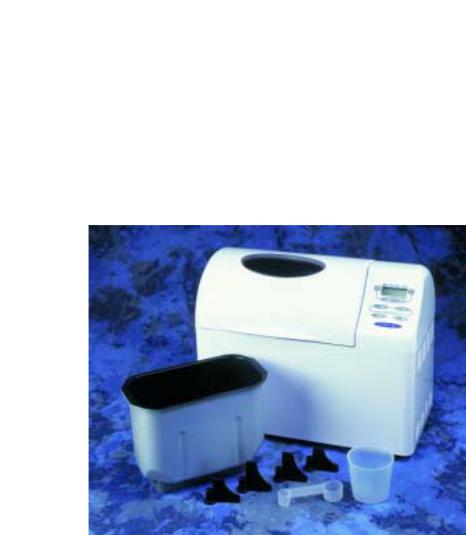
page 10 |
Home Bakery |
• CHECK THE ACCESSORIES |
15 |
At this point it might be a good idea to familiarise yourself with the bread maker and setting the controls.
When you unpack your Home Bakery you should have the following items:
4 kneading blades, (2 large & 2 small). This represents 2 sets of blades, each set comprising one small & one large kneading blade. Keep the spare set in a safe place.
1 measuring cup. You can use this cup for measuring the liquid ingredients or you can use your own measuring jug as long as it’s graduated in ml.
1 measuring spoon. The quantities of sugar, oil & some other ingredients in these recipes are based upon this metric tablespoon (15ml – large end) and metric teaspoon (5ml – small end)
This book. ...which you wouldn’t be reading if it wasn’t included of course!
Open the lid & familiarise yourself with removing & replacing the bread pan. Note that the pan must be properly inserted into the machine before the drive cogs can make proper contact with the kneading shafts. Next, insert the kneading blades (1 large & 1 small). It doesn’t matter which
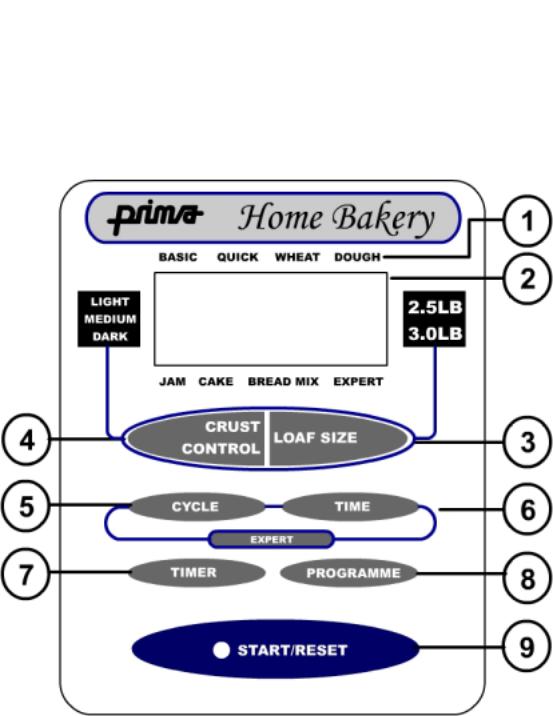
page 11 |
Home Bakery |
way round they go. As you place them over the kneading shaft, rotate them until they lock into place.
• THE CONTROLS |
16 |
1.PROGRAMMES including basic, quick, wheat, dough, jam, cake, bread mix & expert modes.
2.DIGITAL DISPLAY displays time remaining in minutes until end of programme & current selection.
3.LOAF SIZE selects between 2.5lb & 3lb settings
4.CRUST CONTROL selects light, medium & dark
5.CYCLE Use in Expert mode only. Pages through the various steps in the process
6.TIME Adjusts the timing of the individual steps in Expert mode
7.TIMER Use to set the delay timer
8.PROGRAMME Press to select the appropriate programme.
9.START/RESET Press to start process or press & hold for 3 seconds to cancel/reset the process.
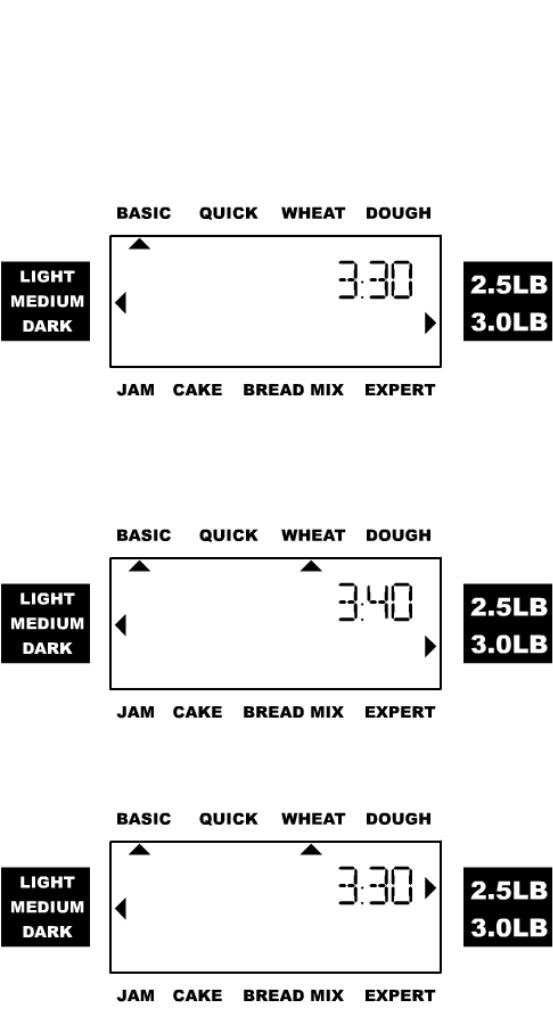
page 12 |
Home Bakery |
• LET’S PRESS SOME BUTTONS! |
17 |
Connect the machine to the mains for the first time & see the following display:
This indicates that the BASIC programme for the 3LB loaf at MEDIUM crust is selected. The process time is 3 hours 30 minutes.
Press the PROGRAMME button once. The display will look like this:
This indicates that the BASIC WHEAT programme is selected. The process time has increased to 3 hours 40 minutes. Press the LOAF SIZE button. The display looks like this:

page 13 |
Home Bakery |
Notice the arrow now points to the 2.5LB setting and the process time has reduced to 3 hours 30 minutes because the loaf will be smaller.
• LET’S PRESS SOME MORE BUTTONS! |
17 |
Pressing the CRUST CONTROL button will cycle through the LIGHT, MEDIUM & DARK crust settings. The process time doesn’t change because the bake temperature is altered, not the bake time. Note: THE CRUST OR LOAF SIZE SETTINGS ARE NOT AVAILABLE FOR ALL MODES.
Please see below a summary of the other modes/programmes.
DISPLAY |
FUNCTION |
|
BASIC. This is the programme |
|
shown when the machine is first |
|
switched on. This is a good, |
|
general-purpose |
|
programme for white or brown |
|
bread. Most of the recipes use this |
|
programme. |
|
BASIC WHEAT. This programme |
|
allows for more kneading/rising time |
|
and is better for whole-wheat or |
|
whole meal bread. |
|
|
|
Basic DOUGH function. Kneads & |
|
rises dough. Ideal for bread rolls |
|
etc., which need to be baked in a |
|
conventional oven. |
|
Note: Loaf size and crust colour |
|
options are not available |
|
|
|
QUICK bread setting. Skips a rising |
|
step to make bread in a shorter |
|
time. |
|
Note: Loaf size is not available in |
|
this mode. |
|
|
|
QUICK WHEAT. Quick whole-wheat |
|
setting. Skips a rising step for a |
|
shorter process time. |
|
Note: Loaf size option is not |
|
available in this mode. |
|
|
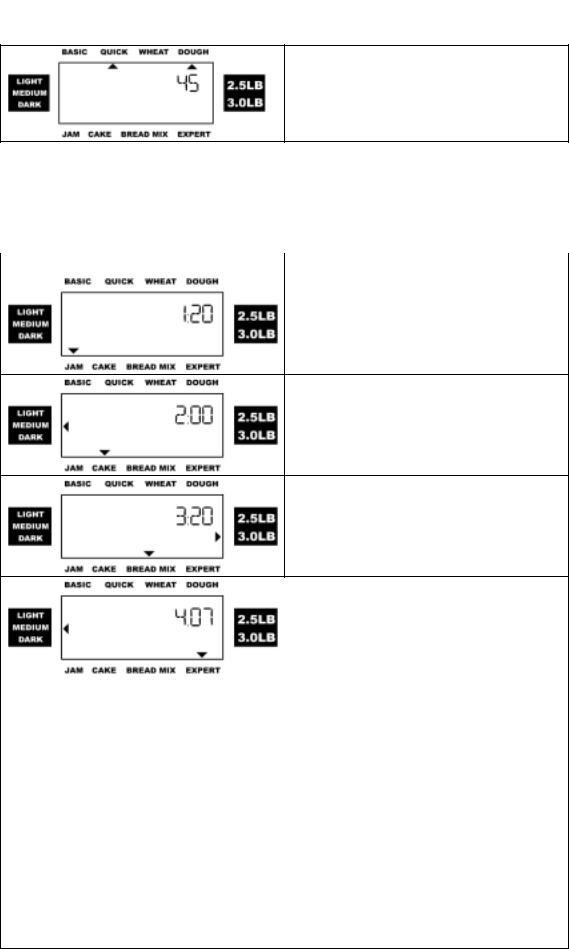
page 14 |
Home Bakery |
QUICK DOUGH. Dough mode that skips 2 rising steps. Ideal if you intend to prove the dough outside the machine.
|
• LET’S PRESS SOME MORE BUTTONS! |
17 |
|
|
|
|
|
|
|
|
DISPLAY |
FUNCTION |
|
|
|
|
JAM. Programme that makes jam. |
|
|
CAKE. Programme for making cakes. Note: The crust colour control IS available in this mode.
BREAD MIX. Programme ideal for the many bread mix products currently available. Note: Loaf size option is available but crust colour is not.
EXPERT MODE. Use in conjunction with the CYCLE & TIME buttons to programme each step in the process to your requirements. Expert mode means exactly that! It’s not a good
idea to use this mode unless you really know what you’re doing. Refer to the chart below (18). Use the CYCLE button to access the various steps. The step you are programming will be shown on the display. Press the TIME button to increase the length of the step in 1
minute increments. Press and hold the TIME button to scroll through the time more quickly.
Expert mode is good if you want to use low protein flour such as organic or locally milled flour, which often needs more kneading to release the gluten. If you just wish to use the BAKE step only you can set all the other steps to zero.
The default settings in Expert mode are ideal for making French bread.
